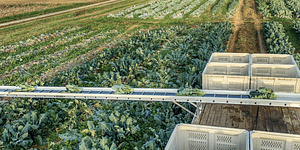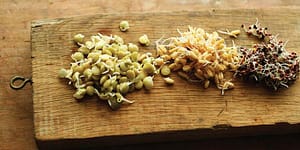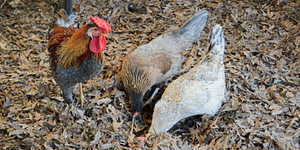Don’t Bawk: The Wild and Wonderful Chicken Tractor

Aside from the sheer pleasure of telling your friends, straight-faced, that you maintain your garden using something called a “chicken tractor,” there are a slew of other benefits to working the land with a few of your animal friends. Getting rid of pests without chemicals, for one; letting them do the work of weeding and tilling the soil—not to mention laying down some natural fertilizer—for another; and don’t forget supplementing your chicken feed bill. Oh, and farm fresh eggs, and meat, if you like.
The following is an excerpt from Gaia’s Garden by Toby Hemenway. It has been adapted for the Web.
One secret to integrating small animals into the garden is a small mobile pen, called an animal tractor. By keeping livestock in a movable enclosure, animal tractors let the gardener decide where the animal will work best, rather than allowing the critters to wander and wreak havoc in freshly seeded beds. The bottomless pens concentrate the animals’ weeding, tilling, and manuring in a small space, which is the key to successfully melding animals and gardens. With an animal tractor, you can have weed-free, surface-tilled, perfectly manured raised beds with only a few minutes of (your) work per day.
Chickens are ideally suited to animal tractors, although ducks, rabbits, pigs, and guinea pigs have been used in these mobile pens. Andy Lee has written an entire book on the subject, Chicken Tractor, which I recommend to anyone planning to use an animal tractor.
 A chicken tractor is a bottomless pen on wheels that fits over a garden bed
A chicken tractor is a bottomless pen on wheels that fits over a garden bed
A typical one might be four feet wide by eight feet long and about two feet high. This design, one of many, is an open wood-frame box, covered on the sides with one-inch chicken wire (poultry netting), roofed with plastic panels, having wheels or skids at one end and a door to let the birds in and out. Inside, food and water containers hang from the roof; in some models, perches project from the sides.
There are other designs, including circular styles, but that’s the gist. To move the pen, just lift one end and roll it on the wheels or skids. Animal tractors work best with garden beds as wide as the tractor, and ideally, in lengths that are an even multiple of the tractor length.
The number of birds per tractor varies with the breed, but as a rule of thumb, a laying hen needs four square feet of room, while a broiler need two square feet. Thus, a thirty-two-square-foot tractor can hold up to eight layers or sixteen broilers.
You can use a chicken tractor to build soil in three basic ways: rotation, sheet mulching, and deep mulching
In the rotation method, first thing in the morning you wheel the pen and chickens to an unused garden bed. The birds can stay inside while you move it—they’ll scurry along inside the pen. Withhold their feed until they’ve been on the new bed for an hour or so. That way the hungry birds will eat the vegetation inside the tractor area. Let the birds weed, till, and manure the soil all day.
The next morning, wheel the tractor down the bed to the next fresh spot and sprinkle some mulch on the first bed. Rotate through all the unused beds. This system requires that some of your garden beds go fallow part of the time so the chickens have soil to improve. Andy Lee’s garden is twice as big as he needs, which lets him rotate chicken tractors through each bed every other year.
As the tractor leaves each raised bed, you can sow a cover crop of buckwheat, or winter rye and vetch, and bring the chickens back to eat and till it again when the cover crop is about four inches high. Not only does this boost fertility and soil life enormously, but it cuts down on chicken feed bills. The result is superb soil with little labor, plus eggs and meat if you wish.
To sheet mulch with chickens, leave the tractor in one spot for several days.
Each day, add about an inch of mulch and let the chickens work over the mulch and add manure to it. When the mulch is about four inches deep, move the chickens to a new spot and repeat the process. This way, you (and the chickens) are adding both nutrients and organic matter to the soil. The mulch binds the nitrogen and other nutrients in place while the whole mixture composts. Treat this bed as you would any new sheet-mulched bed and plant it with seedlings in soil pockets or seeds in a top layer of potting soil.
 You can also use a chicken tractor to make a deep-mulch garden bed
You can also use a chicken tractor to make a deep-mulch garden bed
Useful in gardens too small to move the tractor every day or where the soil is very poor. Leave the chicken tractor in one place and add about an inch of mulch each day. After about five weeks—or the time it takes broilers to grow from chicks to mature—you’ll have a thick raised bed to plant. Andy Lee warns that leaving the tractor in one place this long may give predators—dogs, skunks, foxes—time to dig under the pen and attack the birds. If you’re building a deep-mulch bed, he recommends laying chicken wire on the ground around the pen and pinning it in place to frustrate digging predators.
Both mulch techniques work well on sloping as well as level ground. On a slope, the chickens—and gravity—will leave the mulch thicker on the downhill side of the pen, resulting in a level, terraced bed.
Chickens can also graze free-range in the garden, where they will glean insects, slugs, and weed seeds, but it’s best to keep an eye on them in case they find a crop they really like, such as berries or tomatoes. Wait until garden plants are mature before letting the chickens into the garden, as poultry will happily eat tender seedlings. If you allow the birds into the garden in the late afternoon, they won’t be there long enough to do any damage and will naturally return to their coop or tractor at dusk, sparing you the trouble of a lengthy chicken chase.
Growing some of the chickens’ food will cut down on costs and reduce imports to your site, but it’s not realistic to expect to grow all their food.
A hen needs about eighty pounds of grain a year, which could be grown on about 1,000 square feet. The numbers add up fast: Feeding a small flock of eight hens would require an eighty-by-one-hundred-foot garden and countless hours of labor to grow and harvest the food. Instead, I’d suggest growing multifunctional plants around the yard to supplement the chickens’ diets, which will cut costs and provide valuable vitamins and fresh foods.
These plants could be nicely integrated into the garden design, supplying habitat, food, nutrients, and all the other needs of the ecological garden, rather than just the single function of chicken feed. And growing chicken forage creates yet another closed cycle for the garden. As the chickens build the soil, the resulting food plants will be healthier and more lush, and the chickens in turn grow stronger and more productive.
Recommended Reads
Un-Coop Your Poop: Everything You Need to Know About Chicken Tractors
Recent Articles
Oxeye daisies are one of the most important plants for pollinators including beetles, ants, and moths that use oxeye daisies as a source of pollen and nectar. Instead of thinking about removing a plant like oxeye daisy, consider how you can improve the fertility and diversity of habitat resources in your home landscape, garden, or…
Read MoreSo you want to start reaping your harvest, but you’re not sure where to start? Learn how to break down the options of harvesting tools!
Read MoreWhat’s so great about oyster mushrooms? First, you can add them to the list of foods that can be grown indoors! They are tasty, easy to grow, multiply fast, and they love a variety of substrates, making oyster mushrooms the premium choice. The following is an excerpt from Fresh Food from Small Spaces by R. J.…
Read MoreEver heard the phrase, “always follow your nose?” As it turns out, this is a good rule of thumb when it comes to chicken manure. Composting chicken manure in deep litter helps build better chicken health, reduce labor, and retain most of the nutrients for your garden. The following is an excerpt from The Small-Scale Poultry…
Read More










